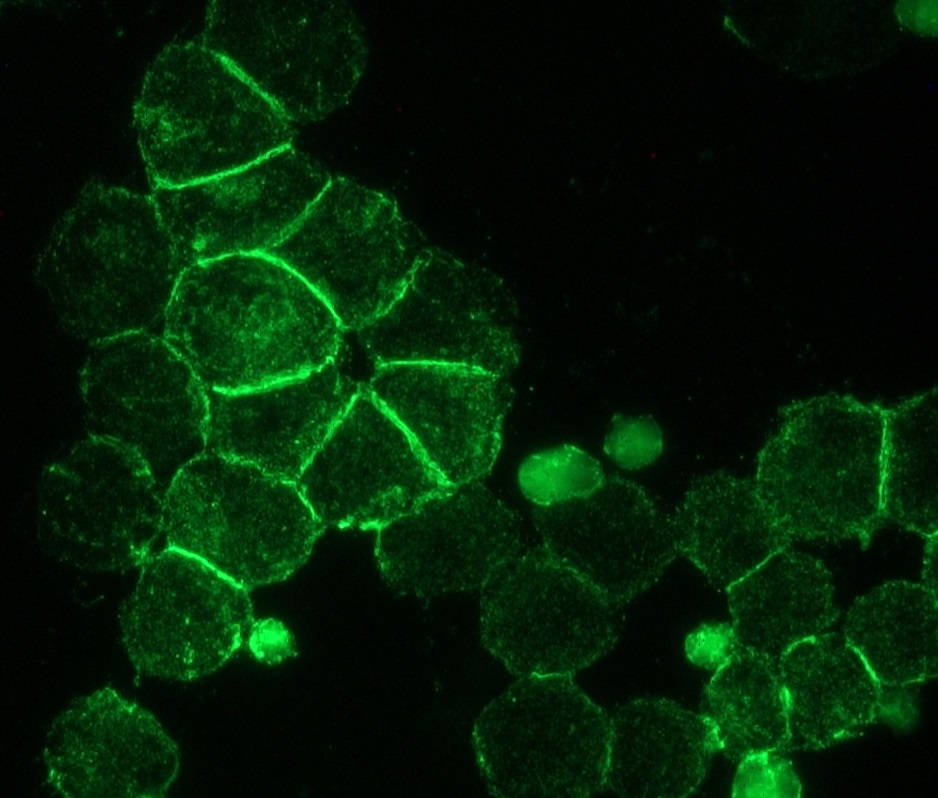Catalogue

Mouse anti NCAM / CD56
Catalog number: MUB1300P| Clone | RNL-1 |
| Isotype | IgG1 |
| Product Type |
Primary Antibodies |
| Units | 0.1 mg |
| Host | Mouse |
| Species Reactivity |
Human Mouse |
| Application |
Immunocytochemistry Immunohistochemistry (frozen) |
Background
NCAM / CD56, as a member of the immunoglobulin superfamily of adhesion molecules is characterized by several immunoglobulin (Ig)-like domains. The extracellular part of NCAM consists of five of these Ig domains and two fibronectin type III homology regions. NCAM is encoded by a single copy gene composed of 26 exons. However, at least 20-30 distinct isoforms can be generated by alternative splicing and by posttranslational modifications, such as sialylation. During sialylation, polysialic acid (PSA) carbohydrates are attached to the extracellular part of NCAM. Through its extracellular region, NCAM mediates homophilic interactions. In addition, NCAM can also undergo heterophilic interactions by binding extracellular matrix components, such as laminin, or other cell adhesion molecules, such as integrins.
NCAM can be found in central and peripheral nerve cells, neuroendocrine tissues and at the surface of NK-cells. Also, NCAM is present in malignancies derived from these tissues and cells.
Source
RNL-1 is a Mouse monoclonal IgG1 antibody derived by fusion of SP2/0-Ag14 Mouse myeloma cells with spleen cells from a BALB/c Mouse immunized with the small cell lung cancer cell line NCI-H82.
Product
Each vial contains 100 ul 1 mg/ml purified monoclonal antibody in PBS containing 0.09% sodium azide.
Formulation: Each vial contains 100 ul 1 mg/ml purified monoclonal antibody in PBS containing 0.09% sodium azide.
Specificity
RNL-1 was defined as a cluster I antibody during the Second International Workshop on Small Cell Lung Cancer (SCLC) Antibodies and recognizes the extracellular region of NCAM / CD56.
Applications
RNL-1 is suitable for immunocytochemistry and immunohistochemistry on frozen tissues. Optimal antibody dilution should be determined by titration; recommended range is 1:100 – 1:200 for immunohistochemistry with fluorochrome conjugated secondary antibodies or avidin-biotinylated horseradish peroxidase complex (ABC) as detection reagent.
Storage
The antibody is shipped at ambient temperature and may be stored at +4°C. For prolonged storage prepare appropriate aliquots and store at or below -20°C. Prior to use, an aliquot is thawed slowly in the dark at ambient temperature, spun down again and used to prepare working dilutions by adding sterile phosphate buffered saline (PBS, pH 7.2). Repeated thawing and freezing should be avoided. Working dilutions should be stored at +4°C, not refrozen, and preferably used the same day. If a slight precipitation occurs upon storage, this should be removed by centrifugation. It will not affect the performance or the concentration of the product.
Caution
This product is intended FOR RESEARCH USE ONLY, and FOR TESTS IN VITRO, not for use in diagnostic or therapeutic procedures involving humans or animals. It may contain hazardous ingredients. Please refer to the Safety Data Sheets (SDS) for additional information and proper handling procedures. Dispose product remainders according to local regulations.This datasheet is as accurate as reasonably achievable, but Nordic-MUbio accepts no liability for any inaccuracies or omissions in this information.
References
1. Broers, J. L., Mijnheere, E. P., Rot, M. K., Schaart, G., Sijlmans, A., Boerman, O. C., and Ramaekers, F. C. (1991). Novel antigens characteristic of neuroendocrine malignancies, Cancer 67, 619-33.
2. Mijnheere, E. P., Boerman, O. C., Broers, J. L., Klein Rot, M., Vooijs, G. P., and Ramaekers, F. C. (1991). Immunotargeting of Human small cell lung cancer xenografts in athymic mice using a monoclonal antibody (RNL-1) anti a neuroendocrine- related antigen, Br J Cancer Suppl 14, 78-81.
3. Boerman, O. C., Mijnheere, E. P., Broers, J. L., Vooijs, G. P., and Ramaekers, F. C. (1991). Biodistribution of a monoclonal antibody (RNL-1) anti the neural cell adhesion molecule (NCAM) in athymic mice bearing Human small-cell lung-cancer xenografts, Int J Cancer 48, 457-62.
4. Mijnheere, E. P., Boerman, O. C., Poels, L. G., Slobbe, R. L., van Eys, G. J. J. M., and Ramaekers, F. C. S. (1996). Pharmacokinetics, biodistribution and dosimetry of anti-NCAM monoclonal antibody RNL-1 and its fragments in experimental lung cancer, Journal of Experimental and Clinical Cancer Research 15, 11-18.
5. Hens, J., Nuydens, R., Geerts, H., Senden, N. H., Van de Ven, W. J., Roebroek, A. J., van de Velde, H. J., Ramaekers, F. C., and Broers, J. L. (1998). Neuronal differentiation is accompanied by NSP-C expression, Cell Tissue Res 292, 229-37.
Safety Datasheet(s) for this product:
| NM_Sodium Azide |

Figure 1. Immunohistochemistry of MUB1300P (RNL-1) on H82 cells, derived from small cell lung cancer, showing strong positive staining for NCAM/CD56 at the sites of intracellular connections. Dilution 1:500.

